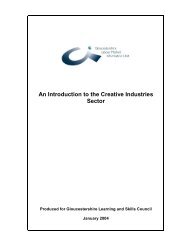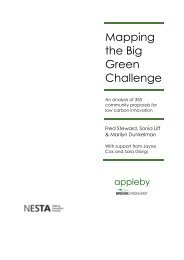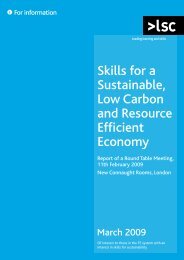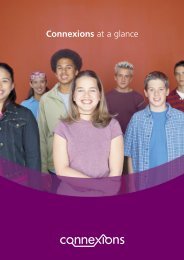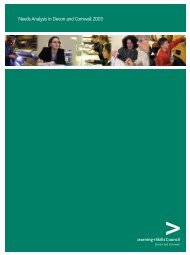Client needs for coherent information, advice and guidance services ...
Client needs for coherent information, advice and guidance services ...
Client needs for coherent information, advice and guidance services ...
Create successful ePaper yourself
Turn your PDF publications into a flip-book with our unique Google optimized e-Paper software.
service can help them; rather it suggests that they recognise that they need some<br />
help to move <strong>for</strong>ward from where they are now.<br />
551 This group includes individuals with a wide range of <strong>needs</strong>. Some have clear career<br />
goals but need help to determine an appropriate strategy <strong>for</strong> achieving those goals.<br />
At the other end of the spectrum are clients who want to change career, or return to<br />
work after a break, but have no idea of what they want to do. Still others might<br />
need help to determine how best to use their existing skills <strong>and</strong> qualifications in the<br />
current employment market.<br />
552 <strong>Client</strong>s who actively seek IAG <strong>services</strong> appear to perceive coherence in terms of<br />
whether they can see how different <strong>services</strong> are contributing to progress towards their<br />
goals. Several well-motivated clients indicated that they would like an action plan,<br />
or some other indication of the various <strong>services</strong> available <strong>and</strong> the different ways in<br />
which they might meet help them meet their <strong>needs</strong>. One client remarked: “you need<br />
to know where it’s all leading - the provider might know but the client doesn’t!”.<br />
553 This group includes many unemployed individuals whose goals are not dissimilar to<br />
those of Jobcentre clients: that is, to find a job. However, these individuals tend to<br />
have been unemployed <strong>for</strong> a shorter duration than the majority of those contacted<br />
through Jobcentre Plus. They also tended to be relatively well-qualified <strong>and</strong><br />
experienced, <strong>and</strong> with higher aspirations <strong>and</strong> confidence in their ability to find<br />
appropriate work. Unlike many Jobcentre clients, this group had, at an early stage,<br />
identified a need <strong>for</strong> help to maximise their chances of obtaining work.<br />
554 For unemployed clients who had actively engaged with IAG provision, the important<br />
factors in relation to coherence were that the service was able to support them<br />
towards their own work goals, continued to suggest new strategies <strong>and</strong> options when<br />
success was not <strong>for</strong>thcoming, <strong>and</strong> offered encouragement that helped the client to<br />
maintain motivation, even in the face of apparent lack of progress. Another key<br />
factor <strong>for</strong> clients who seek IAG is whether their initial contact results in an accurate<br />
diagnosis of need (recognised as such by the client) which leads to an early – <strong>and</strong><br />
shared – underst<strong>and</strong>ing of how progress is to be made towards addressing that need.<br />
Internal <strong>and</strong> external coherence<br />
555 As noted in paragraph 535, clients are strongly focused on their current provider <strong>and</strong><br />
often fail to consider the wider range of in<strong>for</strong>mation <strong>and</strong> <strong>advice</strong> sources. This may<br />
explain why coherence seems to have a more immediate relevance <strong>for</strong> clients when<br />
applied to <strong>services</strong> received within the same organisation (e.g. referral to different<br />
advisers <strong>for</strong> a different type of service internally).<br />
556 The key appears to be having an on-going relationship with a trusted adviser who<br />
can be used as a point of reference <strong>and</strong> sounding board, even though some <strong>services</strong><br />
may be delivered by his/her colleagues. This finding does not only apply to IAG<br />
<strong>services</strong> integrated within a broader programme of provision (e.g. lifeskills training).<br />
Similar conclusions were reached at focus groups with clients of many other IAG<br />
providers, including one-stop-shops, project-based job <strong>and</strong> training workshops <strong>and</strong><br />
Connexions.<br />
557 The strengths to such an on-going relationship are:-<br />
• trust <strong>and</strong> confidence;<br />
• awareness of the ‘history’ (no need to keep explaining how the current position<br />
was reached);<br />
• underst<strong>and</strong>ing of the personal drivers <strong>and</strong> values (no need to keep explaining<br />
what is important or why a particular goal is relevant).<br />
36



